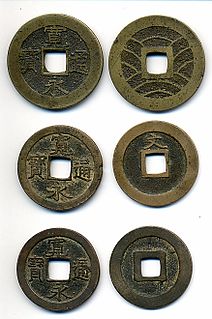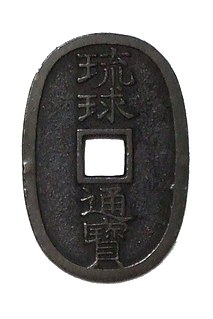Kyōiku kanji, also known as Gakunenbetsu kanji haitōhyō is a list of 1,026 kanji and associated readings developed and maintained by the Japanese Ministry of Education that prescribes which kanji, and which readings of kanji, Japanese students should learn from first grade to the sixth grade. Although the list is designed for Japanese students, it can also be used as a sequence of learning characters by non-native speakers as a means of focusing on the most commonly used kanji.

The mon was the currency of Japan from the Muromachi period in 1336 until the early Meiji period in 1870. It co-circulated with the new sen until 1891. The Kanji for mon is 文 and the character for currency was widely used in the Chinese-character cultural sphere, e.g. Chinese wen, Korean mun, Vietnamese văn. Throughout Japanese history, there were many different styles of currency of many shapes, styles, designs, sizes and materials, including gold, silver, bronze, etc. Coins denominated in mon were cast in copper or iron and circulated alongside silver and gold ingots denominated in shu, bu and ryō, with 4000 mon = 16 shu = 4 bu = 1 ryo. In 1869, due to depreciation against gold, the new fixing officially was set for 1 ryo/yen = equal to 10.000 mon. The yen started to replace the old duodecimal denominations in 1870: in 3rd quarter of 1870, the first new coins appeared, namely 5, 10, 50 sen silver and 2, 5, 10, 20 Yen. Smaller sen coins did not appear before spring, 1873. So the mon coins remained a necessity for ordinary peoples commodities and were allowed to circulate until 31st December, 1891. From January 1, 1954 onward, the mon became invalid: postwar inflation had removed sen, mon etc. denominations smaller than 1 Yen. Due to the missing small coinage, the Japanese posts e.g. issued their first stamps in mon and fixed postal rates in mon until April, 1872.

The 500 yen coin is the largest denomination of Japanese yen coin issued for circulation. These coins were first struck in 1982 as the vending machine industry needed a higher valued coin for use in their machines. The denomination had previously been issued as paper currency which co-circulated with the new coins until 1994. Originally the 500 yen coin was made up of cupronickel, but was later changed to nickel brass, and then to bi-metallic to deter counterfeiting. This illegal practice has been a constant issue since the coin was first released due to its high purchase value. With a history spanning 3 imperial eras, 500 yen coins are also collectibles.

This is a list of development studios owned by Sega, a Japanese video game developer and publisher based in Tokyo, Japan. Also included are the companies that Sega has acquired over the years. For a list full list of games developed and published by Sega, see List of Sega video games and List of Sega arcade games.
The Innovation Network Corporation of Japan(INCJ), headquartered in Tokyo, is a public-private partnership between the Japanese government and 19 major corporations.

A cryptocurrency, crypto-currency, or crypto is a collection of binary data which is designed to work as a medium of exchange. Individual coin ownership records are stored in a ledger, which is a computerized database using strong cryptography to secure transaction records, to control the creation of additional coins, and to verify the transfer of coin ownership. Cryptocurrencies are generally fiat currencies, as they are not backed by or convertible into a commodity. Some crypto schemes use validators to maintain the cryptocurrency. In a proof-of-stake model, owners put up their tokens as collateral. In return, they get authority over the token in proportion to the amount they stake. Generally, these token stakers get additional ownership in the token over time via network fees, newly minted tokens or other such reward mechanisms.

Counterparty is a peer-to-peer financial platform and distributed, open source Internet protocol built on top of the Bitcoin blockchain and network. It was one of the most well-known "Bitcoin 2.0" platforms in 2014, along with Mastercoin, Ethereum, Colored Coins, Ripple and BitShares. It is a "metacoin"-type protocol. It provides such features as tradable user-created currencies, additional financial instruments and a decentralized asset exchange. In November of 2014, Counterparty added support for the Ethereum Virtual Machine to the Counterparty protocol and allowing all Ethereum decentralized applications to be run on the Bitcoin blockchain within the Counterparty protocol.
Coincheck is a Japanese bitcoin wallet and exchange service headquartered in Tokyo, Japan, founded by Koichiro Wada and Yusuke Otsuka. It operates exchanges between bitcoin, ether and fiat currencies in Japan, and bitcoin transactions and storage in some countries.

The Ryukyuan mon was the currency used in the Ryukyu Islands. The Ryukyuan monetary system was based on that of China, like those of many nations in the Sinosphere, with the mon serving as the basic unit, just as with the Japanese mon, Vietnamese văn, and Korean mun. Like Japan had also done for centuries, the Ryukyuans often made use of the already-existing Chinese cash coins when physical currency was needed.

The Tenpō Tsūhō was an Edo period coin with a face value of 100 mon, originally cast in the 6th year of the Tenpō era (1830). The obverse of the coin reads "Tenpō" a reference to the era this coin was designed in, and "Tsūhō" which means "circulating treasure" or currency. The Kaō is that of Gotō San'emon, a member of the Kinza mint's Gotō family, descendants of Gotō Shozaburo Mitsutsugu, a metalworker and engraver from Kyoto appointed by shōgun Tokugawa Ieyasu in 1600 to oversee the Edo mint of his shogunate and oversee its coinage. All mother coins were produced in Edo before they were sent to other mints where they would place the individual mint's mark on the edge of the coin. The coin circulated for 40 years, and stopped being produced during the Meiji Restoration after the introduction of the Japanese yen. Today these coins are now sold as "lucky charms" as well as being collected by numismatists.

Nagasaki trade coins (長崎貿易銭), also known as Nagasaki export coins refer to Japanese mon coins specifically cast for export by the Tokugawa government between 1659 and 1685 during the Sakoku era. Though the inscriptions on the coins often match Chinese coins from the Song dynasty they’re often cast with different typefaces such as the fact that the Genpō Tsūhō (元豊通寳) produced at Nagasaki was in Clerical script while the Song dynasty’s versions were in Seal script and Running script. Due to the success of these coins they’re often still found in modern day Vietnam and Java, and were copied by contemporary Vietnamese mints as they had become the de facto standard coinage in Vietnam as native production had declined in the 17th century. As the export of gold and silver was banned by the Qing dynasty Japanese merchants were most likely to go to Hanoi and Hội An to gain access to Chinese products causing these coins to start circulating en masse on the Vietnamese market. A special “5 elements” series of Nagasaki trade coins were also cast for export to Taiwan.
AQURIA Co., Ltd. is a Japanese game developer based in Yokohama, Japan. The company is mainly engaged in software development of console games.
POI SOFT Co., Ltd. is a Japanese game developer and publisher based in Fukuoka, Japan.
Showroom, stylized as SHOWROOM, is a Japanese live streaming service used primarily for Japanese idols and voice actors. A development of DeNA, it has been integrated into the audition process for idol groups such as 22/7, Nogizaka46, and Keyakizaka46.
Akinobu Kuroda(黑田明伸) is Professor of East Asian History in the Institute for Advanced Studies on Asia, University of Tokyo. He specialises in the complementarity of monies in East Asia, India, Africa, and Europe.
Lamp is a Japanese indie band formed in 2000.

SafeMoon is a cryptocurrency token created in March 2021 on the Binance Smart Chain blockchain.

The Nagasaki Velca are a Japanese professional basketball team based in Nagasaki Prefecture that competes in the third division of the B.League.










